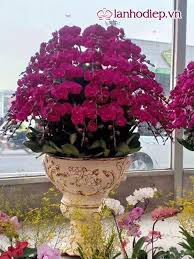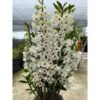# The Harmony of Dendrobium Orchids with Other Houseplants in Living Spaces

Dendrobium orchids, with their elegant blooms and diverse species, have gained popularity among plant enthusiasts and interior decorators alike. Their vibrant colors and unique structures can add a touch of sophistication to any indoor environment. However, combining Dendrobium orchids with other houseplants can enhance their beauty while creating a harmonious living space. This article explores the characteristics of Dendrobium orchids, suitable companion plants, design tips, and maintenance strategies for a balanced indoor garden.
## Understanding Dendrobium Orchids
### Characteristics of Dendrobium Orchids
Dendrobium orchids belong to one of the largest genera in the Orchidaceae family, boasting over 1,800 species and numerous hybrids. They are native to tropical Asia and Australia, thriving in diverse environments. Some key characteristics include:
– **Variety of Colors**: Dendrobium orchids come in various colors, including white, pink, purple, yellow, and even multicolored varieties. This diversity allows for creative combinations with other houseplants.
– **Growth Habit**: These orchids can be either epiphytic (growing on other plants) or terrestrial (growing in the ground). Understanding their growth habit is crucial for selecting compatible plants.
– **Blooming Cycle**: Dendrobium orchids typically bloom once a year, but their flowers can last several weeks. The blooming period can vary based on species and environmental conditions.
### Ideal Growing Conditions
Dendrobium orchids thrive in bright, indirect light and require specific temperature and humidity levels to flourish:
– **Light**: They prefer bright, indirect sunlight. Direct sunlight can scorch their leaves, while insufficient light can hinder blooming.
– **Temperature**: Ideal temperatures range from 65°F to 85°F (18°C to 29°C) during the day and slightly cooler at night.
– **Humidity**: Dendrobiums enjoy humidity levels between 40% and 70%. Maintaining adequate humidity is vital for their overall health and blooming.
## Companion Plants for Dendrobium Orchids
When selecting companion plants for Dendrobium orchids, consider factors such as light requirements, humidity needs, and overall aesthetics. Here are some plants that pair well with Dendrobium orchids:
### 1. **Ferns**
Ferns, such as Boston ferns (Nephrolepis exaltata) or maidenhair ferns (Adiantum spp.), thrive in similar humidity conditions as Dendrobium orchids. Their lush foliage can create a beautiful contrast with the delicate flowers of Dendrobium.
– **Care Tips**: Keep ferns in a shaded area with indirect light. Ensure the soil remains consistently moist but not soggy.
### 2. **Peace Lilies**
Peace lilies (Spathiphyllum spp.) are another excellent companion plant. They enjoy similar light and humidity levels and produce stunning white flowers that complement the vibrant blooms of Dendrobium.
– **Care Tips**: Peace lilies thrive in low to medium light and require consistently moist soil. Avoid overwatering, as this can lead to root rot.
### 3. **Pothos**
Pothos (Epipremnum aureum) is a popular trailing plant that adapts well to various light conditions. Its heart-shaped leaves add texture and visual interest when combined with Dendrobium orchids.
– **Care Tips**: Pothos prefers indirect light and should be watered when the top inch of the soil feels dry. It’s a low-maintenance plant that thrives in various environments.
### 4. **Dracaena**
Dracaena plants, such as Dracaena marginata or Dracaena fragrans, can coexist beautifully with Dendrobium orchids. They require similar light conditions and add height to your indoor garden.
– **Care Tips**: Dracaenas thrive in bright, indirect light and prefer to dry out slightly between waterings. Avoid overwatering to prevent root issues.
### 5. **Spider Plants**
Spider plants (Chlorophytum comosum) are resilient and thrive in various lighting conditions. Their arching leaves create a striking contrast with the vertical growth habit of Dendrobium orchids.
– **Care Tips**: Spider plants prefer indirect light and should be watered when the soil feels dry. They are forgiving and can tolerate occasional neglect.
## Design Tips for Combining Dendrobium Orchids with Other Plants
Creating a visually appealing arrangement with Dendrobium orchids and other houseplants requires careful planning and consideration of design elements. Here are some tips to achieve a harmonious look:
### 1. **Layering Heights**
Incorporate plants of varying heights to create visual interest. Place taller plants like Dracaena or ferns in the back and shorter plants, such as peace lilies or pothos, in the front. This arrangement allows each plant to be seen and appreciated.
### 2. **Color Coordination**
Consider the color palette of your Dendrobium orchids and companion plants. For example, if you have a vibrant purple Dendrobium, consider pairing it with white peace lilies or green ferns to create a balanced look. Avoid overcrowding with too many colors, as this can create visual chaos.
### 3. **Texture Variation**
Mix plants with different leaf textures to add depth to your arrangement. Pair the smooth, waxy leaves of Dendrobium orchids with the frilly leaves of ferns or the broad leaves of peace lilies for a dynamic composition.
### 4. **Using Decorative Containers**
Choose containers that complement the overall aesthetic of your living space. Consider using terracotta pots, ceramic containers, or decorative planters to enhance the look of your arrangement. Ensure that all pots have drainage holes to prevent waterlogging.
### 5. **Grouping Plants Together**
Group plants together to create a mini indoor garden. Use a plant stand or a tray to unify the arrangement, making it visually cohesive. Consider placing them on a windowsill, coffee table, or shelf where they can be easily admired.
## Maintenance Strategies for a Thriving Indoor Garden
Once you’ve created a harmonious living space with Dendrobium orchids and companion plants, it’s essential to maintain their health and beauty. Here are some maintenance tips:
### 1. **Watering Practices**
Water your plants according to their specific needs. While Dendrobium orchids prefer to dry out between waterings, other plants may require more consistent moisture. Use a moisture meter or check the top inch of the soil to determine when to water.
### 2. **Humidity Control**
Maintain humidity levels by using a humidity tray filled with water and pebbles or a room humidifier. Regular misting can also help, but avoid waterlogging the leaves, which can lead to fungal issues.
### 3. **Fertilization**
Dendrobium orchids benefit from a balanced orchid fertilizer during their active growing season. Follow the manufacturer’s instructions for dilution rates and frequency. Companion plants may have different fertilization needs, so ensure you are using the right fertilizer for each type of plant.
### 4. **Pruning and Deadheading**
Regularly prune and deadhead your plants to promote healthy growth and prevent overcrowding. Remove dead or yellowing leaves to keep your arrangement looking fresh.
### 5. **Pest Control**
Monitor your plants for signs of pests, such as aphids or spider mites. Regularly inspect the leaves and stems, and treat infestations promptly with insecticidal soap or neem oil.
### 6. **Seasonal Adjustments**
Adjust care routines based on seasonal changes. For example, during the winter months, Dendrobium orchids may require less water and fertilizer as they enter dormancy. Similarly, indoor humidity may drop in winter, so be vigilant about maintaining moisture levels.
## Benefits of Combining Dendrobium Orchids with Other Plants
Creating a harmonious arrangement of Dendrobium orchids and other houseplants offers several benefits:
### 1. **Enhanced Aesthetics**
Combining plants with varying colors, textures, and heights creates a visually striking display that enhances your living space.
### 2. **Improved Air Quality**
Plants improve indoor air quality by filtering toxins and releasing oxygen. A diverse plant arrangement can significantly enhance the overall air quality in your home.
### 3. **Increased Humidity**
Grouping plants together can help create a microclimate with higher humidity levels, benefiting humidity-loving plants like Dendrobium orchids.
### 4. **Mental Well-Being**
Surrounding yourself with plants can improve mood and reduce stress levels. Gardening and plant care are known to have therapeutic effects, making your indoor garden a source of joy and relaxation.
### 5. **Educational Opportunities**
Combining different plant species provides an opportunity to learn about their unique care requirements, growth habits, and environmental needs. This knowledge can enhance your gardening skills and foster a deeper appreciation for nature.
## Conclusion
Dendrobium orchids are a stunning addition to any indoor garden, and when combined with suitable companion plants, they can create a beautiful and harmonious living space. By understanding their unique characteristics, choosing the right plants, and employing thoughtful design strategies, you can cultivate a vibrant indoor oasis that enhances your home’s aesthetic appeal and contributes to your well-being. With proper care and attention, your Dendrobium orchids and their companions will thrive, bringing joy and beauty to your living environment for years to come.

